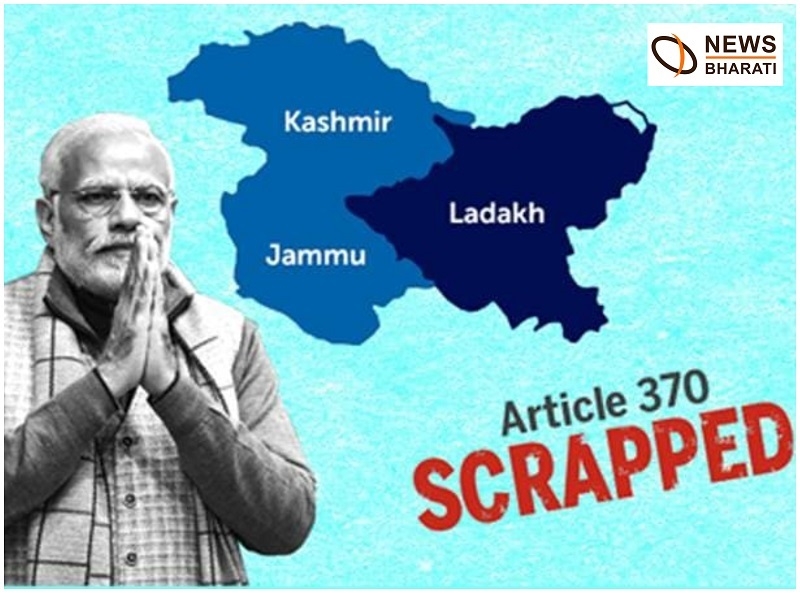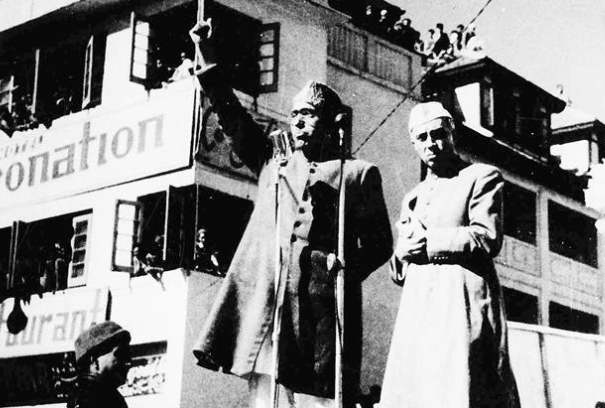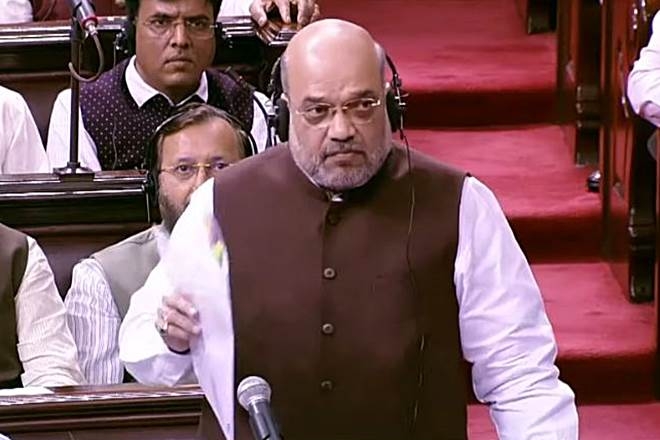The archive reel for reality of Art 370- Narendra Modi’s yet another master stroke!
Total Views |
Instrument of Accession : 26th October , 1947
It is important to study the instrument of accession of Kingdom/State of J & K into India.
The full text of the Instrument of Accession (Jammu and Kashmir) executed by Maharaja Hari Singh on 26 October 1947 and accepted by Lord Mountbatten of Burma, Governor-General of India, on 27 October 1947 (excluding the schedule mentioned in its third point) is as follows:
“ Whereas the Indian Independence Act 1947, provides that as from the fifteenth day of August, 1947, there shall be set up an Independent Dominion known as India, and that the Government of India Act, 1935 shall, with such omission, additions, adaptations and modifications as the governor-general may by order specify, be applicable to the Dominion of India.

And whereas the Government of India Act, 1935, as so adapted by the governor-general, provides that an Indian State may accede to the Dominion of India by an Instrument of Accession executed by the Ruler thereof.
Now, therefore, I Shriman Inder Mahander Rajrajeswar Maharajadhiraj Shri Hari Singhji, Jammu and Kashmir Naresh Tatha Tibbetadi Deshadhipathi, Ruler of Jammu and Kashmir State, in the exercise of my sovereignty in and over my said State do hereby execute this my Instrument of Accession and
1. I hereby declare that I accede to the Dominion of India with the intent that the governor-general of India, the Dominion Legislature, the Federal Court and any other Dominion authority established for the purposes of the Dominion shall, by virtue of this my Instrument of Accession but subject always to the terms thereof, and for the purposes only of the Dominion, exercise in relation to the State of Jammu and Kashmir (hereinafter referred to as "this State") such functions as may be vested in them by or under the Government of India Act, 1935, as in force in the Dominion of India, on the 15th day of August, 1947, (which Act as so in force is hereafter referred to as "the Act").
2. I hereby assume the obligation of ensuring that due effect is given to the provisions of the Act within this state so far as they are applicable therein by virtue of this my Instrument of Accession.
3. I accept the matters specified in the schedule hereto as the matters with respect to which the Dominion Legislatures may make laws for this state.
4. I hereby declare that I accede to the Dominion of India on the assurance that if an agreement is made between the Governor General and the ruler of this state whereby any functions in relation to the administration in this state of any law of the Dominion Legislature shall be exercised by the ruler of this state, then any such agreement shall be deem to form part of this Instrument and shall be construed and have effect accordingly.
5. The terms of this my Instrument of accession shall not be varied by any amendment of the Act or of the Indian Independence Act 1947 unless such amendment is accepted by me by an Instrument supplementary to this Instrument.
6. Nothing in this Instrument shall empower the Dominion Legislature to make any law for this state authorizing the compulsory acquisition of land for any purpose, but I hereby undertake that should the Dominion for the purposes of a Dominion law which applies in this state deem it necessary to acquire any land, I will at their request acquire the land at their expense or if the land belongs to me transfer it to them on such terms as may be agreed, or, in default of agreement, determined by an arbitrator to be appointed by the Chief Justice Of India.
7. Nothing in this Instrument shall be deemed to commit me in any way to acceptance of any future constitution of India or to fetter my discretion to enter into arrangements with the Government of India under any such future constitution.
8. Nothing in this Instrument affects the continuance of my sovereignty in and over this state, or, save as provided by or under this Instrument, the exercise of any powers, authority and rights now enjoyed by me as Ruler of this state or the validity of any law at present in force in this state.
9. I hereby declare that I execute this Instrument on behalf of this state and that any reference in this Instrument to me or to the ruler of the state is to be construed as including to my heirs and successors.
Given under my hand this 26th day of OCTOBER nineteen hundred and forty seven.
Hari Singh ----Maharajadhiraj of Jammu and Kashmir State. Sd/
I do hereby accept this Instrument of Accession. Dated this twenty seventh day of October, nineteen hundred and forty seven.
Sd/ (Mountbatten of Burma, Governor General of India).

This is the crux of the study. At every stage, the text of the Instrument is required to be borne in mind. There is no mention of Article 370 or any such suggestion of the sort in that behalf.
Abrogating Article 370 from the Constitution of India is a master stroke of Narendra Modi concluding the final step of Indian independence political process by doing away with the then temporary and provisional Article.
The footnote thereof states, “ In exercise of the powers conferred by this article , the President, on the recommendation of the Constituent Assembly of the State of Jammu and Kashmir, declared that, as from the 17th day of November, 1952, the said article 370 shall be operative with the modification that for the explanation in clause ( 1 ) thereof , the following Explanation is substituted namely----
Explanation---For the purposes of this Article, the Government of the State means the person for the time being recognized by the President on the recommendation of the Legislative Assembly of the State as the “ Sadar-i-Riyasat of Jammu and Kashmir, acting on the advice of the Council of Ministers of the State for the time being in Office”
Article 370 of the Indian constitution used to give special status to the region of Jammu and Kashmir. The article was drafted in Part XXI of the Constitution: Temporary, Transitional and Special Provisions. The Constituent Assembly of Jammu and Kashmir, after its establishment, was empowered to recommend the articles of the Indian constitution that should be applied to the state or to abrogate the Article 370 altogether. After the J&K Constituent Assembly later created the state's constitution and dissolved itself without recommending the abrogation of Article 370, the article was deemed to have become a permanent feature of the Indian Constitution.
This article, along with Article 35A, defined that the J&K state's residents live under a separate set of laws, including those related to citizenship, ownership of property, and fundamental rights, as compared to resident of other Indian states. As a result of this provision, Indian citizens from other states cannot purchase land or property in Jammu & Kashmir.
On 5 August 2019, the President of India Ram Nath Kovind issued a constitutional order revoking the 1954 order, and making all the provisions of the Indian constitution applicable to Jammu and Kashmir. The order rendered the Article 370 and Article 35A of the Indian constitution ineffective. Home Minister Amit Shah introduced a resolution in the upper house of the Parliament, Rajya Sabha, seeking to reorganize the state with Jammu and Kashmir serving as a Union Territory and Ladakh region as a separate union territory.
The clause 7 of the Instrument of Accession signed by Maharaja Hari Singh declared that the State could not be compelled to accept any future Constitution of India. The State was within its rights to draft its own Constitution and to decide for itself what additional powers to extend to the Central Government. The Article 370 was designed to protect those rights. According to the constitutional scholar A. G. Noorani, the Article 370 records a 'solemn compact'. Neither India nor the State can unilaterally amend or abrogate the Article except in accordance with the terms of the Article.
Article 370 embodied six special provisions for Jammu and Kashmir:
1 It exempted the State from the complete applicability of the Constitution of India. The State was allowed to have its own Constitution.
2 Central legislative powers over the State were limited, at the time of framing, to the three subjects of defense, foreign affairs and communications.
3 Other constitutional powers of the Central Government could be extended to the State only with the concurrence of the State Government.
4 The 'concurrence' was only provisional. It had to be ratified by the State's Constituent Assembly.
5 The State Government's authority to give 'concurrence' lasted only until the State Constituent Assembly was convened. Once the State Constituent Assembly finalised the scheme of powers and dispersed, no further extension of powers was possible.
6 The Article 370 could be abrogated or amended only upon the recommendation of the State's Constituent Assembly.
Rule by Presidential orders
In exercise of the powers conferred by clause (1) of article 370 of the Constitution, the President, made a series of orders.
Presidential order of 1950
The Presidential order of 1950, officially The Constitution (Application to Jammu and Kashmir) Order, 1950, came into force on 26 January 1950 contemporaneously with the Constitution of India. It specified the subjects and articles of the Indian Constitution that corresponded to the Instrument of Accession as required by the clause b (i) of the Article 370. This order was superseded by the Presidential order of 1954.
Presidential order of 1952
The Presidential order of 1952 was issued on 15 November 1952, at the request of the state government. It amended the Article 370, replacing the phrase "recognised by the President as the Maharaja of Jammu and Kashmir" by "recognized by the President on the recommendation of the Legislative Assembly of the State as the Sadr-i-Riyasat". The amendment represented the abolition of the monarchy of Jammu and Kashmir.
Presidential order of 1954
The Presidential order of 1954, officially The Constitution (Application to Jammu and Kashmir) Order, 1954 came into force on 14 May 1954. Issued with the agreement of the State's Constituent Assembly, it was a comprehensive order seeking to implement the 1952 Delhi Agreement. Arguably, it went further than the Delhi Agreement in some respects.
The provisions implementing the Delhi Agreement were: ( I ) Indian citizenship was extended to the 'permanent residents' of Jammu and Kashmir (formerly called 'state subjects'). (ii) Simultaneously, the Article 35A was added to the Constitution, empowering the state legislature to legislate on the privileges of permanent residents with regard to immovable property, settlement in the state and employment. (iii) The fundamental rights of the Indian constitution were extended to the state. However, the State Legislature was empowered to legislate on preventive detention for the purpose of internal security. (iv) The State's land reform legislation (which acquired land without compensation) was also protected.(v) The jurisdiction of the Supreme Court of India was extended to the State. (vi) The Central Government was given power to declare national emergency in the event of external aggression. However, its power to do so for internal disturbances could be exercised only with the concurrence of the State Government.
The State Government's decision to abolish the monarchy led to increased agitation by the Jammu Praja Parishad, which found support among the Ladakhi Buddhists and the Hindu parties of India. In response, Sheikh Abdullah started questioning the value of Kashmir's accession to India, leading to a loss of support among his Cabinet members. On 8 August 1953, Sheikh Abdullah was dismissed from the post of prime minister by the Sadar-i-Riyasat Karan Singh and his erstwhile deputy Bakshi Ghulam Mohammad was appointed in his place. Abdullah and several of his colleagues were arrested and put in prison.
Further Presidential orders
In addition to these original orders, forty seven Presidential orders had been issued between 11 February 1956 and 19 February 1994, making various other provisions of the Constitution of India applicable to Jammu and Kashmir. All these orders were issued with the 'concurrence of the Government of the State' without any Constituent Assembly. The effect of these orders had been to extend 94 of the 97 subjects in the Union List (the powers of the Central Government) to the State of Jammu and Kashmir, and 260 of the 395 Articles of the Constitution of India. All of these orders had been issued as amendments to the Presidential Order of 1954, rather than as replacements to it, presumably because their constitutionality was in doubt. This process has been termed the 'erosion' of the Article 370.
On 5 August 2019, President Kovind had issued a presidential order under Article 370, superseding the 1954 order. The order states that all the provisions of the Indian Constitution apply to Jammu and Kashmir, effectively abrogating the separate Constitution of the state; the constitutionality and effect of this action is contested in the public sphere.
Finally, the “temporary” provision under Article 370 with regard to the erstwhile “Jammu and Kashmir’ State was passed with a sweeping majority in both the Houses of the Parliament. In Rajya Sabha it was passed with 125 favoring and 61 against it. In Lok Sabha it was passed by 370 favoring and 70 against it.

The leading media reported as following :
( Quote ) :“The Lok Sabha was adjourned sine die on Tuesday after clearing the extraordinary statutory resolution curtailing Article 370, which gives special status to Jammu and Kashmir, and a Bill for splitting the State into two Union Territories — Jammu and Kashmir, and Ladakh .
Home Minister Amit Shah, who piloted the resolution and the Bill, also told the Lok Sabha that India will continue to claim the territories of J&K occupied by Pakistan and ruled out any talks with the separatist Hurriyat Conference. “India will continue to claim Pakistan-occupied Kashmir,” he said.
Shah said Article 370 had been creating doubts over J&K’s relations with India. “This is not a historical blunder, but we are rectifying the historical blunder,” he said dismissing the Opposition charges that the government was committing a mistake.
The Opposition accused the Centre of not consulting the “stakeholders” before taking a decision on abrogating the provisions of Article 370, a charge rejected by the treasury benches, which said Parliament represents the will of the people.
The resolution with regard to Article 370 was passed by Lok Sabha with 351 members voting in its support and 72 against, while one member abstained. The Bill to create two UTs was passed in the House by 370 votes in favour and 70 against.” The resolution and the Bill were approved by the Rajya Sabha on Monday the 5th August, 2019.
Creating history ---Master stroke for a confident future by Narendra Modi
The Indian Independence process finally concluded by curtailing the powers under Article 370 by diffusing it. It began with the “Instrument of Accession” jointly by Raja Hari Singh and Lord Mountbatten of Burma and Governor-General of India on 27th October 1947 and it came to an end with Prime Minister Narendra Modi and Home Minister Amit Shah on the floor of the House on 5th and 6th of August, 2019.
Narendra Modi- The Game changer in international politics.
Modi changed the battle field of the ‘Kashmir issue’ as was made by some international powers and made it an internal affair of the country. This was a slap on the face of those powers who considered their natural right to be international mediators. Modi hoodwinked. Modi succeeded in changing the international game on the one hand and made internal political opponents irrelevant.
Narendra Modi a political giant fulfilled all the aspirations of all those who expected all these from Modi viz., the Rashtriya Swayamsevak Sangh , the Bharatiya Janata Party , and the people of India. He emerged as the author of history, but never faced distracted as he was a firm believer in the ‘mantra’ –“nation first”.
